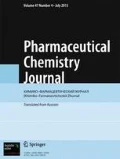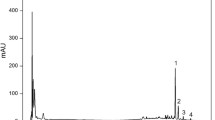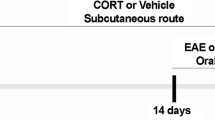Abstract
The antidepressant activity of some phytopreparations and phenylpropanoids was studied in white rats, which were subjected to the desperation test and neuropharmacological tests based on the antagonist activity with respect to reserpine, clofelin, and L-DOPA. The most pronounced effect was exhibited by the extract of Eleutherococcus senticosus, which produced a 56.4% decrease in the immobilization period in rats that was comparable with, albeit somewhat lower than the effect of amitriptyline (73.5%). The antidepressant effects of other phytopreparations decreased in the following order: Rhodiola rosea (53.8%), Echinacea purpurea (49%), and Schizandra chinensis (29.8%). Among phenylpropanoids, the maximum antidepressant effects were produced by syringin and rosavin (49.7% and 29.5%, respectively). The most pronounced antagonism with respect to reserpine was also observed for syringin. The tinctures of Echinacea purpurea and Schizandra chinensis, as well as phenylpropanoid triandrin produced the maximum antidepressant effect in the clofelin-induced depression test. An increase in the stimulating action of L-DOPA was observed upon the administration of rosavin and the tinctures of Schizandra chinensis and Echinacea purpurea.
Similar content being viewed by others
References
V. A. Bykov, G. G. Zapesochnaya, and V. A. Kurkin, Khim.-Farm. Zh., 33(1), 28–32 (1999).
V. A. Kurkin, N. A. Grinenko, and G. G. Zapesochnaya, Khim. Prir. Soedin., No. 6, 768–771 (1991).
V. A. Kurkin, Phenylpropanoids: Promising Natural Biologically Active Substances [in Russian], Samara State University, Samara (1996).
V. A. Kurkin, Pharmacognostics (A Handbook for Students) [in Russian], Ofort, Samara (2004).
V. A. Kurkin, G. G. Zapesochnaya, E. V. Avdeeva, and V. N. Ezhkov, Phenylpropanoids: Independent Class of Biologically Active Substances [in Russian], Ofort, Samara (2005).
A. S. Saratikov and E. A. Krasnov, Pink Rhodiola: A Valuable Medicinal Plant (Golden Root) [in Russian], Tomsk (1987).
S. Ya. Sokolov, V. P. Boiko, V. A. Kurkin, et al., Khim.-Farm. Zh., 24(10), 66–68 (1990).
R. Bauer, H. Wagner, Echinacea: Handbuch für Artze, Apotheker und andere Naturwissenschaftler, Wissenschaftliche Verlags–geselschaft, Stuttgart (1990).
H. Wagner, Pharmazeutische Biologie. Drogen und ihre Inhaltsstoffe, Gustav Fischer Verlag, Stuttgart-New York (1993).
Methodological Recommendation on the Experimental (Pre-clinical) Investigation of New Pharmaceuticals [in Russian], T. A. Voronina and S. B. Seredenin (eds.), Pharmacological Committee of the Ministry of Public Health, Moscow (2000), pp. 122–136.
S. Barnes and J. A. Davies, J. Pharmacol. Exp. Ther., 120, 125–136 (1957).
Author information
Authors and Affiliations
Additional information
__________
Translated from Khimiko-Farmatsevticheskii Zhurnal, Vol. 40, No. 11, pp. 33–38, November, 2006.
Rights and permissions
About this article
Cite this article
Kurkin, V.A., Dubishchev, A.V., Ezhkov, V.N. et al. Antidepressant activity of some phytopharmaceuticals and phenylpropanoids. Pharm Chem J 40, 614–619 (2006). https://doi.org/10.1007/s11094-006-0205-5
Received:
Issue Date:
DOI: https://doi.org/10.1007/s11094-006-0205-5




